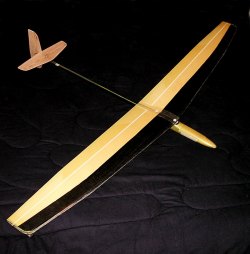|
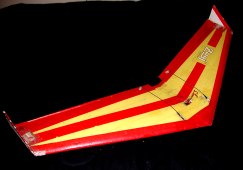 - (Nov 2005 - Most of page is very out of date, but I just want to say, forget the
Zagi 3C or the Zagi 5C or the Jazz Extreme. The Windrider Bee is a
superior combat wing in every way (faster, stronger, more durable, cheaper, easier build).
Pick one up from Predator Wings)
-
- What follows is my original review of the Zagi.
Trick RC Zagi 3C
(all EPP combat wing) - Retired. It hasn't seen
much combat with other gliders, but it has survived many battles with the ground, rocks,
bushes, a hawk or two and the occasional post and it just keeps on flying. I picked
it up as my very first R/C glider Christmas 2000 because I'd heard it was reasonably quick
maneuverable and indestructible. True on all counts, although there are
faster EPP swept wings out there like the Boomerang
and Jazz Xtreme. The
Zagi has been a faithful flyer, but it's finally worn out
and I wanted to use its gear in the Jazz. (Somehow the carbon spars got beat to death too) The Zagi is a great way to
learn ailerons with minial risk and minimal cost. I taught myself to fly from
scratch on the Zagi, having flown various flight sims over the years. It can
often be found at local hobby stores for less than what Trick RC charges and goes together
in about 2 nights. About $50.
I learned a couple things about the Zagi early on. (Generally applies to all
Zagi models
but especially the EPP ones)
- The suggested CG is too far forward. Move the CG back by removing
some of that nose weight until the elevons trimmed out flatter during level flight.
It'll fly faster, tip stall less, and be much more responsive.
- Crash it nose first. If it needs to go down, it can survive
a 60mph impact with the ground on its nose, but a 5mph impact with the ground on its
elevons will break them or the servos. That means you're more likely to hurt
it trying to land it slow, or catch it, and miss. If it's going down, nose it in.
- If you experience the infamous Zagi Spiral of Death (you'll know), push
the nose down as hard as you can. Fly it at the ground, and pull out only when the
spiral has quit and you've got some airspeed up.
- Use your Zagi to test the air for other gliders. If the 3C will
fly, so will most anything else.
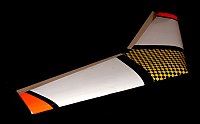 Well, I said
above how I had retired the Zagi 3C. It lives again. Stripped off
all the old covering, shaved the spars down, cut the ends off where they were mangled,
Gooped and hot melt glued it all back together, recovered strong, and now it flies as good
(better actually) than new. Still a faithful all rounder Well, I said
above how I had retired the Zagi 3C. It lives again. Stripped off
all the old covering, shaved the spars down, cut the ends off where they were mangled,
Gooped and hot melt glued it all back together, recovered strong, and now it flies as good
(better actually) than new. Still a faithful all rounder
|
|
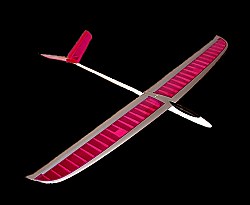
Northeast Sailplanes Omega
HLG - The Zagi 3C won't hang in light air (not for lack of trying), and I saw
someone flying an Eli 2 (no longer available as far as I know), so knew I needed a
handlaunch. Sal at NESail was having problems getting the Eli 2 in so he recommended
the Omega HLG. These two gliders couldn't be more different. Eli 2 is a
slow flying poly. The Omega is a fast flying flaperon glider. As
my second glider and a crunchie to boot, learning to fly this thing was not without its
bad moments. A Zagi managed to occupy the same airspace as me on the first
day I flew it, snapped the joiner rod, pulled one wing pin through the fuse, and it fell
75 feet nose down, and left a hole in the ground. The fuse was cracked 3/4 the way through, and abused everywhere.
The wing was dented but otherwise undamaged. I repaired it easily. It
had a couple other bad crashes (an errant post, and
later some high wind following an epic inland thermal). It's now heavier than most
HLGs but I got better at the controls, and it hasn't had a bad landing in 9 months or
more. Even though it is very fast, one way I found to minimize trauma was to
learn how to catch it. Anyway, I've been very happy with the Omega HLG
overall as it is fast enough to fly on the slope and will slow down and climb in a light
thermal and is maneuverable. It has drawn many many positive comments
from others on the slope for its looks. There are some areas of the fuse
that should be reinforced *before* the first flight. Email me for details.
(I'll put em up here eventually)
Here are some photos of my Omega just after building. Top, Side,.Cockpit, small 720mAh NiMH
4xAAAA battery, installed. (Also put that
same battery in my Nemesis)
|
|
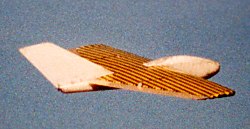
Bowman's Hobbies JW
- 58" EPP DS Demon. Like a lot of slope fliers I saw videos of DS and knew I
needed to get me some of that. No one in the my area does it regularly for some
reason. The JW was getting rave reviews as an impact resistant DS machine.
It is that. It's also rock solid stable on the front side and
flies through turbulence like it isn't there. It's quite relaxing to fly
close to the ground at high speeds because it's so stable. I've had moderate
success DSing it, with my best being about 8 continuous turns on the backside. Just
need more practice. It has taken some truly ballistic impacts and is
still flying. Check out some videos of my JW doing
aerobatics on the frontside.
Photos here. Flying my JW on the frontside in front of
Denver, Flying my JW in front of Red Rocks on a
cold day.
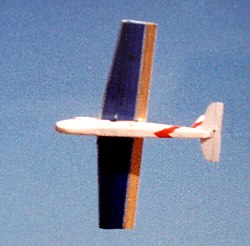
Bowman's Hobbies Scooter - I saw someone flying a Scooter on a high wind day and
he was doing continuous snap rolls 3 or 4 at a time 4 feet over the hill. The
secret to the Scooter is that it has only a 36" wing span, very thin fast wing
profile and weighs about 13oz, making for a high wing loading. It'll work the
very thinnest lift band so can fly on small slopes and keeping it up in moderately light
stuff, but can also penetrate into a 30mph wind. I recently found that
it was the *only* foamie I had at the time, that could fly in a 45+mph wind, because I was
able to strap 4.5oz of lead on the top bringing the wing loading up to 19oz/sq-ft and it
could fly when literally everything else blew away. The only other glider on the
slope at the time was a 60" crunchie with 25oz of lead
strapped to it. The Scooter's roll rate is amazing, it's very maneuverable,
and it's absolutely sickenly cute because it's so small. It seems to
have about the same wing loading as the local hawks because I've parked it right next to a
hawk and just sat there in formation for 10 minutes. I recommend flying
with dual rates so you can do the mega snap rolls, but also slow it down a bit for finer
control at higher airspeeds.
Photos of it here. Parked next to a hawk, Splat.. Occupying the same airspace.
|
|
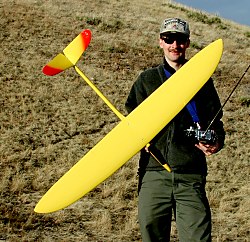
Composite Specialties Nemesis
- This is a 60" moulded slope racer. My inspiration for getting one was
seeing how fast the Charlie Richards Renegade flies (not easily available any more), and
knowing I needed something comparable. The Nemesis flies in almost no lift and
seems to extract energy from nowhere through shear force of will and speed.
It is a big tricky to get down sometimes because it lands fast, although with enough
spoileron it'll slow right now. I've only flown it with about 5 1/2 oz of ballast so
far, which helps, but I know it could use more sometimes. I have DSed it
a couple times now, and it it's sorta scary how fast it flits through thet turns.
I think I need an even lower rate dual rate setting because it feels a little
twitchy at 80+ mph. Photos of my Nemesis can be found here and a couple here.
There's also some videos of it flying on my videos
page. Check em out.
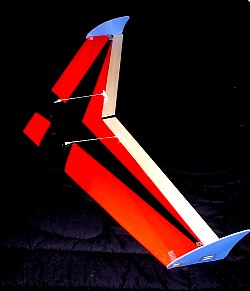
Canterbury Sailplanes Jazz Xtreme - This is the replacement to my much abused Zagi 3C
to be used as my primary EPP flying wing. It's faster than my Zagi was
and more maneuverable. Mine came out a bit heavy because I built it very
strong for combat and DS duty, and thus it seems to fly right past all the other combat
wings on the slope and I've already DSed on a small hill unballasted. It'll
still stay up in modately light lift, penetrates into very high winds and I've even nearly
specked it out thermalling. I've flown it in combat a few times so far
and the main trick is figuring out how to deal with its speed. I tried
to build it slippery. I've got simple scotch tape wipers on the bottom to span the
hinge gap and I used plastic spoons cut with the handles
cut out over the servo horns for better aerodynamics and for impact protection.
Photos. Top, Bottom,
Spoon Covers, Head
on
.
|
|
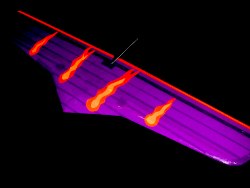
North County Flying Machines Bluto - May very well be the fastest 48" EPP glider
available today. Unbelievable energy retention and it simply doesn't fly slow.
The longer you fly the faster it gets. This is liable
to replace the JW as my primary high speed, higher wind, dynamic soaring glider.
It's got about 3 times the roll rate of the JW or Nemesis too. It's very
very fast out of the box, but I also built it with a ballast tube so it should be
able to fly in nearly anything I can throw at it. Here's my complete
review of it, and build photos. I've DSed it a few
times and it makes *really* big fast loops. It takes a lot of attention to fly
as does any 48" plane at 80-90mph, but so far it's been the easiest to DS of any of
my gliders. It gets a lot of attention from other people on the slope too.
They now are selling a 56" version that's supposed to
be "in a whole other league" (faster, more stable, better in every way), so of
course I've got one of those on the way too.
|
|
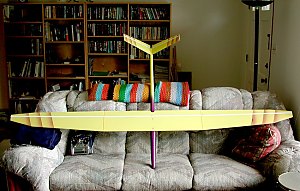 - Aeromod Miiraj from Composite Specialties.
- This is an F3F competition plane (noone flies F3F around here, but I wanted a big fast
sloper so this is it). I bought it used, so it was pre-built. The
original owner even has a Stylus transmitter so he sent me all his settings, I plugged
them into the radio, supplied a crystal for the receiver, and was flying a couple hours
after it arrived here. I don't mind building, but I'd much rather be
flying. Anyway, it's big (97.6" span dwarfs my 8 foot couch here), and
fast, although the scale of the thing kind of throws me off. It doesn't always seem
fast compared to my Nemesis, but after flying the Miraj for a while, and then switching to
the Nemesis it seems fast and slow at the same time because it's not much more than half
the size. The Nemesis looks fast, the Miraj eats up more sky in the same
amount of time, but looks slower. The Miraj is very stable, has good roll
response, is quiet because it's not hollow moulded (top wing surface is moulded and then
they attach the bottom surface along with a foam core). The original owner
said it hadn't been DSed, so of course the 3rd day I had it, I dropped it off the
backside. Very stable, very fast, and easy to fly on the
backside. I made a couple turns yesterday behind the dam, and followed it with
a 400 foot zoom. Wheee.. Big planes like this are really easy to fly
because they've got a lot of rotational inertia, and the big flap and crow setting allow
it to slow right down to land or just park somewhere over the slope. I
flew it in some bigger winds with a pound of ballast (it takes up to 1 1/2 pounds) and it
does great. Have got some videos of it DSing in super light winds.
Need the DiVX Codec from DiVX.com to view
them. Here they are. Slow turns,
and faster turns.
|
|
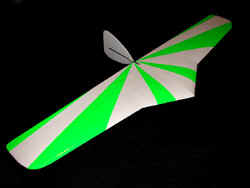
The new improved 56" Bluto from NCFM. Everything the 48"
Bluto is, but bigger, faster, more stable and with amazing energy
retention. Did I mention FASTER.. I've DSed it only briefly
in sub optimal conditions and the main thing I noticed was huge energy retention and it
slices through the turbulence like it isn't there. Have flown it on the frontside
some and it eats up huge expanses of sky and while quite heavy does ok in moderately light
winds, although it's not a floater, and doesn't handle light. I'm pretty
sure there isn't a wind that can be said to be too strong for it. I
built it with a tube big enough to hold 20oz of weight, but I doubt I'll ever use more
than half that. I flew it at NCAR in 25-40mph winds with a bunch of combat wings, a
1-26 and the Bluto made em all look like they were standing still.
Here are my extensive build photos
for the 56" Bluto. I've got a new
page dedicated to the Bluto 56 as well.
|
|
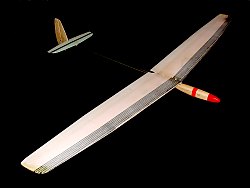
This is the Ed Berg Bolo 60" DLG. Ed Berg is
a friend and flying buddy as well as a builder. He used some Mark Drela camber
changing airfoils and couple different 60" DLGs with pod and boom fuselages and
foam/balsa stabs. I told him I wanted one after seeing his fly and he built it
and I bought it. It's a great flier for the conditions we fly which is mixed slope
and thermal flying. It's a bit heavy for a DLG so it's not going to win any
competitions, but I'm getting 80 foot launches out of
it and it's quite strong. Since I got this, the Omega HLG hasn't seen
much use. I can discus this thing up to nearly the same height I could mini hi-start
the Omega and this does everything the Omega does and more. It's fast, has
large flaperons so it is aerobatic, and slows down pretty good on final approach.
I fly it with no gyro as it has a large vertical stab, and I just hold a
little rudder over with my thumb on launch. Here's a photo of the wing peg installation.
|
|
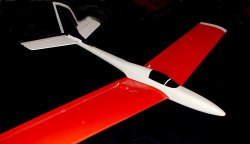
This is a Bob Martin Coyote. It's fairly well
known for having a Duralene fuselage making it nearly indestructible. It
has a sheeted foam wing and late 80's vintage airfoil. I set out specifically
to buy this plane or the Bob Martin SR-7 to get my hands on a Duralene fuse, and then
either fly it as is, or see if I can talk Ed into helping me design some new faster wings
for it. The idea was to have a crunchie that I could fly in more challenging
locations like Mt. Zion and Loveland pass without great fear of smashing the fuse all to
pieces. I've only flown it on one day, from the top of Loveland pass with a
somewhat cobbled together radio setup. It needed something like 6 oz of nose weight
to ballance so this beasty is pretty heavy, but it flies fine. Not a huge speed
range with this airfoil and the ailerons are too small, but all that can be fixed.
I'm looking forward to some bigger winter winds so I can get it out again.
When I got this thing, the fuselage was pretty beat up, and was sort of a mud color.
I found a way to restore the Duralene surface to perfection. I hit it
with the soft buffing wheel on the dremel tool, which pulled the dirt out of the scratches
and then smoothed the scratches right down. That left a very smooth, but slightly
matt finish. I then went over with a simple small diameter wooden dowel, and block
of balsa rubbing it vigorously, which actually put a smooth near mirror finish back on the
plastic. It now looks good as new. 1, 2
|
|
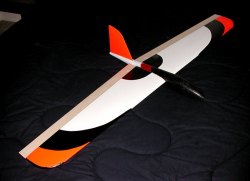
This is the 48" Moth from NCFM. This little screamer is much like the 48"
Bluto but is somewhat lighter. For its weight, it may be the fastest 48" foamie
around. Ballasted up to the Bluto's weight it should be about as fast.
It's fast, aerobatic, good looking and has great energy retention.
Some photos of it following my build.
1, 2, 3, 4, 5, 6, concept1, concept2
flying1, flying2, flying3, flying4, flying5,
Also check out my music video of the Moth flying on the
Videos Page
|
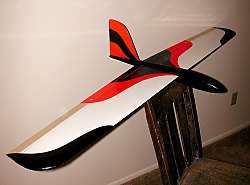
- This is the 60" M60 from
NCFM. This thing is bigger, badder, faster, better than the Moth. It has
nearly the all out speed of the 56" Bluto, but also turns and rolls much more
quickly, and has a wider speed range. It's more forgiving at slow speeds than the
Bluto and just flies a razor sharp line at high speeds, and loves to fly inverted.
I've built two so far. First one suffered a mechanical failure at
100+mph and went straight into the ground. I ordered a replacement immediately, and
the second is now flying.
A bunch of construction photos and some video clips of it flying can be found here.
|

 Well, I said
above how I had retired the Zagi 3C. It lives again. Stripped off
all the old covering, shaved the spars down, cut the ends off where they were mangled,
Gooped and hot melt glued it all back together, recovered strong, and now it flies as good
(better actually) than new. Still a faithful all rounder
Well, I said
above how I had retired the Zagi 3C. It lives again. Stripped off
all the old covering, shaved the spars down, cut the ends off where they were mangled,
Gooped and hot melt glued it all back together, recovered strong, and now it flies as good
(better actually) than new. Still a faithful all rounder











